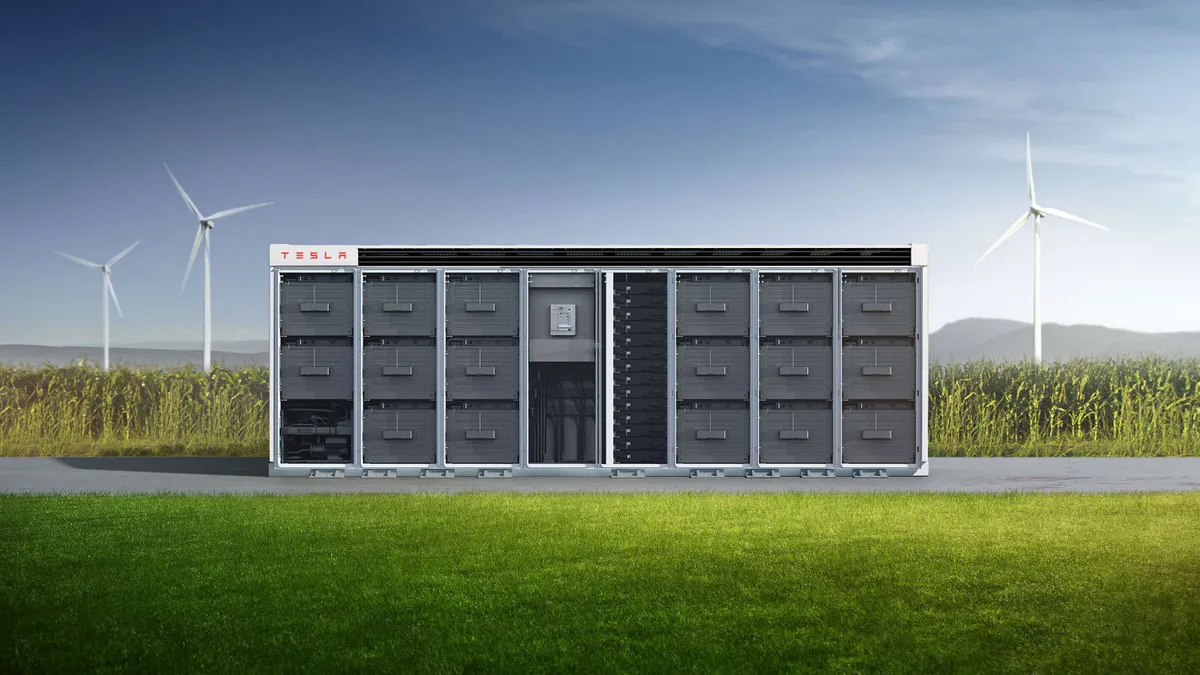Dive Brief:
- Global energy storage deployments will nearly triple in 2021 compared to last year, reaching 12 GW/28 GWh this year, according to a new report from Wood Mackenzie.
- The research group's Global Energy Storage Outlook says that decarbonization of the energy sectors in the U.S. and China will drive the need for a boom in storage deployments, with nearly 1 TWh in demand forecast from 2021-2030. The U.S. and China will account for more than 70% of that demand, the report found.
- In July, the Chinese government announced a goal of installing more than 30 GW of new energy storage capacity by 2025 as part of a decarbonization push. That goal had an "outsized impact" on Wood Mackenzie's front-of-the-meter (FTM) projects for Asia, said senior research analyst Le Xu in a statement.
Dive Insight:
The Wood Mackenzie report reflects the key role that storage plays in the electric grid's transition to renewable generation. Storage projects — including lithium-ion batteries — can help mitigate the intermittency of wind and solar and help deliver power when it is needed. The Biden administration, as part of its campaign to decarbonize the grid by 2035, has worked to boost the storage industry, putting market incentives and research and development efforts behind the technology.
Of particular importance is the existing investment tax credit (ITC) for storage paired with solar applications. The credit has "supercharged" demand, the report found, resulting in a 4.5 times increase in annual FTM deployments for 2021. Tax language for the budget reconciliation bill passed by the House Ways and Means Committee would extend the ITC for standalone storage projects, a move the Biden administration has also proposed. That would "provide upside" to the Wood Mackenzie's latest 10-year outlook, the report said.
As it stands, the U.S. and Canada are poised to deploy 15 GWh of annual capacity in 2021, up from just 4 GWh in 2020, the report found. Over the next five years, "increasingly diverse state markets" will lead to more storage investments, especially in Texas, New York and the PJM Interconnection region, eventually building to a cumulative capacity just shy of 400 GWh by 2030. Residential storage, the researchers found, will also "continue to surge," a trend already seen in states like California and Texas that have weathered recent power outages.
Overall, behind-the-meter markets are expanding, with 57 GWh of new deployments projected by 2030 as costs drop and more consumers purchase solar panels and electric vehicles.
Earlier this week, IHS Markit released a report predicting that annual global energy storage installations could top 20 GW in 2024 and 30 GW by 2030. However, the report warned that a limited supply of lithium-ion batteries and competition with electric vehicle manufacturers could squeeze the market. Separately, the Energy Information Administration wrote in August that the combined capacity of U.S. battery storage projects, which increased 28% in 2019, could grow by 10 times between 2021 and 2023 and could contribute 10,000 MW to the grid.
"Increasing focus on the energy transition as a way of stimulating green growth has led to a flood of ambitious energy storage targets announced by governments globally," said George Hilton, an IHS Markit senior analyst for clean energy technology, in a statement. "This has significantly strengthened our outlook for the industry as it becomes poised to start a prolonged period of strong growth through to 2030."
The Asia Pacific market will also account for substantial growth in the next decade, with projections that the region could grow 20-fold and reach 400 GWh of total storage capacity by 2030. China alone will see FTM storage installations more than triple in 2021 and provide 260 GWh of new capacity by the end of the decade. Europe will also see significant demand, with cumulative installations projected to top 100 GWh by 2030, with Germany and Italy accounting for the most growth.














